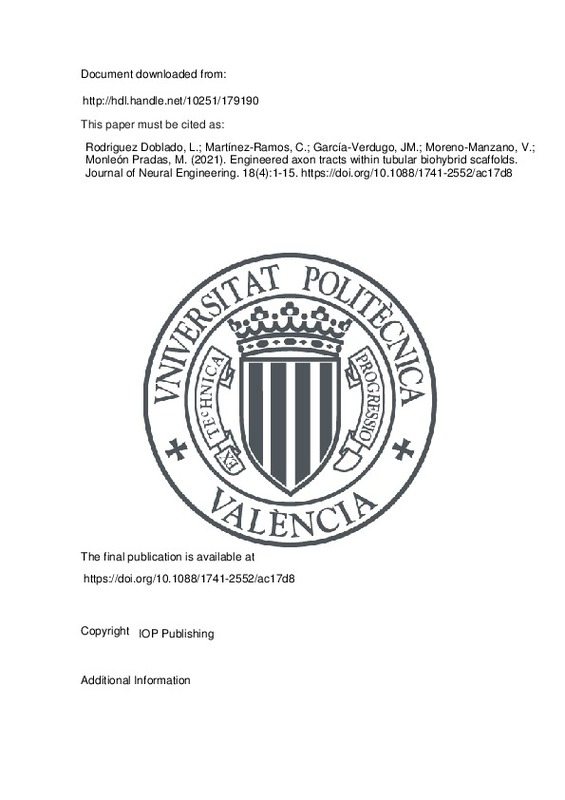JavaScript is disabled for your browser. Some features of this site may not work without it.
Buscar en RiuNet
Listar
Mi cuenta
Estadísticas
Ayuda RiuNet
Admin. UPV
Engineered axon tracts within tubular biohybrid scaffolds
Mostrar el registro sencillo del ítem
Ficheros en el ítem
| dc.contributor.author | Rodriguez Doblado, Laura
|
es_ES |
| dc.contributor.author | Martínez-Ramos, Cristina
|
es_ES |
| dc.contributor.author | García-Verdugo, José Manuel
|
es_ES |
| dc.contributor.author | Moreno-Manzano, Victoria
|
es_ES |
| dc.contributor.author | Monleón Pradas, Manuel
|
es_ES |
| dc.date.accessioned | 2021-12-30T19:27:05Z | |
| dc.date.available | 2021-12-30T19:27:05Z | |
| dc.date.issued | 2021-08-12 | es_ES |
| dc.identifier.issn | 1741-2560 | es_ES |
| dc.identifier.uri | http://hdl.handle.net/10251/179190 | |
| dc.description.abstract | [EN] Injuries to the nervous system that involve the disruption of axonal pathways are devastating to the individual and require specific tissue engineering strategies. Here we analyse a cells-biomaterials strategy to overcome the obstacles limiting axon regeneration in vivo, based on the combination of a hyaluronic acid (HA) single-channel tubular conduit filled with poly-L-lactide acid (PLA) fibres in its lumen, with pre-cultured Schwann cells (SCs) as cells supportive of axon extension. The HA conduit and PLA fibres sustain the proliferation of SC, which enhance axon growth acting as a feeder layer and growth factor pumps. The parallel unidirectional ensemble formed by PLA fibres and SC tries to recapitulate the directional features of axonal pathways in the nervous system. A dorsal root ganglion (DRG) explant is planted on one of the conduit's ends to follow axon outgrowth from the DRG. After a 21 d co-culture of the DRG + SC-seeded conduit ensemble, we analyse the axonal extension throughout the conduit by scanning, transmission electronic and confocal microscopy, in order to study the features of SC and the grown axons and their association. The separate effects of SC and PLA fibres on the axon growth are also experimentally addressed. The biohybrid thus produced may be considered a synthetic axonal pathway, and the results could be of use in strategies for the regeneration of axonal tracts. | es_ES |
| dc.description.sponsorship | The authors acknowledge financing from the Spanish Ministry of Economy and Competitiveness through MINECO grants, Funded by AEI 'RTI2018-095872-B-C21 and C22/ERDF', the Valencian Council for Innovation, Universities, Science and Digital Society (PROMETEO/2019/075 to J.M.G-V,) and the Spanish Cell Therapy Network (TerCel-RD16/0011/0026 to J.M.G-V.). Laura Rodríguez Doblado acknowledges scholarship FPU15/04975 of the Spanish Ministry of Education, Culture and Sports. We thank the Microscopy Service at the UPV, where the FESEM images were obtained and Patricia García-Tarraga for her technical support. | es_ES |
| dc.language | Inglés | es_ES |
| dc.publisher | IOP Publishing | es_ES |
| dc.relation.ispartof | Journal of Neural Engineering | es_ES |
| dc.rights | Reserva de todos los derechos | es_ES |
| dc.subject | Schwann cell culture | es_ES |
| dc.subject | Axon tract | es_ES |
| dc.subject | Dorsal root ganglion cell culture | es_ES |
| dc.subject | Hyaluronic acid conduit | es_ES |
| dc.subject | Poly-lactic fibres | es_ES |
| dc.subject.classification | TERMODINAMICA APLICADA (UPV) | es_ES |
| dc.subject.classification | MAQUINAS Y MOTORES TERMICOS | es_ES |
| dc.title | Engineered axon tracts within tubular biohybrid scaffolds | es_ES |
| dc.type | Artículo | es_ES |
| dc.identifier.doi | 10.1088/1741-2552/ac17d8 | es_ES |
| dc.relation.projectID | info:eu-repo/grantAgreement/AEI/Plan Estatal de Investigación Científica y Técnica y de Innovación 2017-2020/RTI2018-095872-B-C22/ES/NUEVO DISPOSITIVO BIOACTIVO PARA LA REGENERACION DE LESIONES DE LA MEDULA ESPINAL./ | es_ES |
| dc.relation.projectID | info:eu-repo/grantAgreement/FEDER//C22%2FERDF/ | es_ES |
| dc.relation.projectID | info:eu-repo/grantAgreement/MECD//FPU15%2F04975/ES/FPU15%2F04975/ | es_ES |
| dc.relation.projectID | info:eu-repo/grantAgreement/GVA//PROMETEO%2F2019%2F075/ | es_ES |
| dc.relation.projectID | info:eu-repo/grantAgreement/MINECO//RD16%2F0011%2F0026/ES/Red de Terapia Celular (TerCel)/ | es_ES |
| dc.rights.accessRights | Abierto | es_ES |
| dc.contributor.affiliation | Universitat Politècnica de València. Departamento de Termodinámica Aplicada - Departament de Termodinàmica Aplicada | es_ES |
| dc.description.bibliographicCitation | Rodriguez Doblado, L.; Martínez-Ramos, C.; García-Verdugo, JM.; Moreno-Manzano, V.; Monleón Pradas, M. (2021). Engineered axon tracts within tubular biohybrid scaffolds. Journal of Neural Engineering. 18(4):1-15. https://doi.org/10.1088/1741-2552/ac17d8 | es_ES |
| dc.description.accrualMethod | S | es_ES |
| dc.relation.publisherversion | https://doi.org/10.1088/1741-2552/ac17d8 | es_ES |
| dc.description.upvformatpinicio | 1 | es_ES |
| dc.description.upvformatpfin | 15 | es_ES |
| dc.type.version | info:eu-repo/semantics/publishedVersion | es_ES |
| dc.description.volume | 18 | es_ES |
| dc.description.issue | 4 | es_ES |
| dc.identifier.pmid | 34311448 | es_ES |
| dc.relation.pasarela | S\418564 | es_ES |
| dc.contributor.funder | Generalitat Valenciana | es_ES |
| dc.contributor.funder | MINISTERIO DE EDUCACION | es_ES |
| dc.contributor.funder | AGENCIA ESTATAL DE INVESTIGACION | es_ES |
| dc.contributor.funder | European Regional Development Fund | es_ES |
| dc.contributor.funder | Ministerio de Economía y Competitividad | es_ES |







![[Cerrado]](/themes/UPV/images/candado.png)

